| Pages:
1
..
3
4
5
6
7
..
10 |
j_sum1
Administrator
       
Posts: 6218
Registered: 4-10-2014
Location: Unmoved
Member Is Offline
Mood: Organised
|
|
Duh.
I hate it when I overlook the obvious.
|
|
|
unionised
International Hazard
    
Posts: 5102
Registered: 1-11-2003
Location: UK
Member Is Offline
Mood: No Mood
|
|
Quote: Originally posted by BOD513  | | Soaking the bread in a ferric chloride solution before carbonizing it would probably increase the degree of graphitization, and you could then just
wash the iron ii,iii oxide off with hcl. This might make electroplating it easier. |
I think that two wrongs have made a right here.
If you heat Fe oxides to a high temperature you end up with a remarkably insoluble mixed oxide- it's only slowly acted on by acids.
However if you heat them under strongly reducing conditions- such as you would get on a carbon foam, you will get metallic iron which is much easier
to dissolve in acid.
|
|
|
aga
Forum Drunkard
    
Posts: 7030
Registered: 25-3-2014
Member Is Offline
|
|
On to some actual Science ...
Is there a reaction that only works appreciably well with the presence of a catalyst that could be used as a test for this stuff ?
To be clear, a reaction that would be useable to do a Scientific test of this burnt toast.
For example: bread baked with FeCl3 and then pyrolised might catylise chlorinination of toluene, as anhydrous FeCl3 is said to
do. On an effectively 'activated' carbon support, it might do it quicker.
That may be a really bad example, i dunno.
Some reaction where the effectiveness of the catalyst can be measured, also using things an amateur chemist might have available/on-hand.
|
|
|
BOD513
Harmless

Posts: 10
Registered: 15-2-2016
Member Is Offline
Mood: No Mood
|
|
Unionised,
I've seen papers describing "catalytic graphitization" which uses transition metal salts to lower the temperature at which pyrolytic carbons start to
graphitize- this increases conductivity of the finished carbon beyond just impregnating it with a metal or oxide, and the metals can be washed/etched
off afterwards with hcl. The temperatures used are still high enough to probably require a kiln, though.
Googling "catalytic graphitization" will give a bunch of results but here are a few
This paper describes using nickel nitrate and wood
http://authors.library.caltech.edu/47220/1/_JMR_JMR26_01_S08...
This one uses iron (paywall)
http://pubs.rsc.org/en/Content/ArticleLanding/2015/GC/c4gc01...
Video where a guy does it with toilet paper and ferric chloride solution
https://youtu.be/xQKpK1pEAjk
Edit- spelling
[Edited on 8-11-2016 by BOD513]
|
|
|
j_sum1
Administrator
       
Posts: 6218
Registered: 4-10-2014
Location: Unmoved
Member Is Offline
Mood: Organised
|
|
This seems exciting. But I perceive drawbacks.
The feedstock is CO2 dissolved in water.
The CO2 is converted to ethanol at an efficiency of 63%
So the product is a slightly fizzy and slightly alcoholic liquor. Now that sounds like it might have some applications [burp] but not in the field of
making fuel -- unless there can be discovered a way of concentrating the ethanol in a highly energy efficient manner.
|
|
|
aga
Forum Drunkard
    
Posts: 7030
Registered: 25-3-2014
Member Is Offline
|
|
Solar distillery ?
Robert Murray-Smith once again shows us that there's nothing new under the Sun.
Interesting that the addition of ferric chloride reduces the temperature required to achieve graphitisation.
|
|
|
BOD513
Harmless

Posts: 10
Registered: 15-2-2016
Member Is Offline
Mood: No Mood
|
|
He used to have a bunch of good videos on carbon foams but it looks like most of them are private now, which is a shame. I have a small kiln I can try
this out with this weekend, but I have to find a canister that will fit- I've found out the hard way that al foil doesn't do much of a job at
excluding air past 500C
|
|
|
Morgan
International Hazard
    
Posts: 1660
Registered: 28-12-2010
Member Is Offline
Mood: No Mood
|
|
There's this tool wrap foil but it's relatively expensive.
http://www.use-enco.com/CGI/INPDFF?PMPAGE=854&PARTPG=INL...
How is Tool Wrap used?
"It is used in the heat treating process when a controlled vacuum furnace is not available. It saves time by allowing the hardening process to be done
on the premises, without time lost due to parts being sent out for heat treatment. The tool, die or part to be heat treated is placed in an envelope
formed by folding a sheet of Tool Wrap in half and carefully sealing the open ends of the envelope. This Tool Wrap envelope locks out the air and
imitates the results which could be obtained from a vacuum furnace."
"Must the Tool Wrap package be air tight throughout the entire heating & hardening process?
Usually, if the Tool Wrap envelope is not airtight, the heat draws in excess oxygen which causes pitting and scaling on the surface of your part.
However, if it is an odd shaped piece, you may need a vent during the pre-heat process. It is also important to note that there is no difference in
uniformity of hardness between loosely or tightly wrapped pieces."
"The average operating temperature for our Type 321 Stainless Tool Wrap is 1850 degrees F, but it can work in temperatures up to 2000 degrees F.
Overall operating temperature for Tool Wrap is very hard to state specifically because these temperatures are contingent upon the length of time in
the furnace. At 1850 degrees F Tool Wrap can stay in a furnace without degrading for more than four hours. At 2000 degrees F Tool Wrap can perform
successfully up to four hours. Of course, these are just estimates and users also need to be sure their furnaces are calibrated correctly. Other
elements which can effect operating temperatures and overall Tool Wrap performance are contaminants within the envelope and improper sealing. So,
there is no direct answer to what temperature Precision Brand Tool Wrap works at. Before responding to the operating temperature, the heating times
need to be known."
http://precisionbrand.com/faq/tool-wrap/
[Edited on 8-11-2016 by Morgan]
|
|
|
Jstuyfzand
Hazard to Others
  
Posts: 166
Registered: 16-1-2016
Location: Netherlands
Member Is Offline
Mood: Learning, Sorta.
|
|
Quote: Originally posted by aga  |
Solar distillery ?
Robert Murray-Smith once again shows us that there's nothing new under the Sun.
Interesting that the addition of ferric chloride reduces the temperature required to achieve graphitisation. |
Does anybody have a source for at what temperature graphitization normally occurs without addition of catalysts?
The Wiki mentions 2000C for carbon fiber, but that seems a stretch 
|
|
|
Morgan
International Hazard
    
Posts: 1660
Registered: 28-12-2010
Member Is Offline
Mood: No Mood
|
|
Here's one company's outline for graphitization.
http://www.graphiteconcept.com/content/view/33/27/
Tidbit
http://www.nature.com/nature/journal/v177/n4501/abs/177239a0...
[Edited on 8-11-2016 by Morgan]
|
|
|
Jstuyfzand
Hazard to Others
  
Posts: 166
Registered: 16-1-2016
Location: Netherlands
Member Is Offline
Mood: Learning, Sorta.
|
|
Thank you.
That video mentioned that with a metal salt graphitiziation occured at 800C, quite an improvement.
I wonder how the conductivity will hold up when he washes the iron out though.
|
|
|
unionised
International Hazard
    
Posts: 5102
Registered: 1-11-2003
Location: UK
Member Is Offline
Mood: No Mood
|
|
I didn't check the paywalled one, but there's nothing in the others which shows whether the active catalyst is the metal, an oxide or even (in some
cases) a carbonyl.
However, the reality is that it's generally quite easy to reduce Cu,Fe or Ni to the metal and it's generally more difficult to graphitise carbon so,
when you have finished and let everything cool, the free metal is a reasonable product, ad that's a lot easier to dissolve in acid.
|
|
|
ave369
Eastern European Lady of Mad Science
   
Posts: 596
Registered: 8-7-2015
Location: No Location
Member Is Offline
Mood: No Mood
|
|
I think it's a pretty horrible electrode. Normal graphite electrodes erode and foul the electrolytes with graphite dust. This one, I think, will
disintegrate in an instant.
Smells like ammonia....
|
|
|
Jstuyfzand
Hazard to Others
  
Posts: 166
Registered: 16-1-2016
Location: Netherlands
Member Is Offline
Mood: Learning, Sorta.
|
|
Quote: Originally posted by ave369  |
I think it's a pretty horrible electrode. Normal graphite electrodes erode and foul the electrolytes with graphite dust. This one, I think, will
disintegrate in an instant. |
Depends on what you use it for, water electrolysis would be not so tough on them.
I think that carbonized bread would be less useful than for example Wood pieces.
|
|
|
Toady
Harmless

Posts: 15
Registered: 16-10-2016
Location: Beyond the pale
Member Is Offline
Mood: PISSED
|
|
Violet sin-you may wish to hold off on those PARTICULAR mushrooms.
Whilst I won't say 'yes eat them' I am more than willing to point towards species that I believe them to be so you can get a proper ID in books.
Some look like those of the Ceps clade, Boletus edulis, B.aereus etc.
The one with the dun-brown cap looks like a potential bay bolete (B.badius recently transferred to the same family as the red cracking bolete, so now
B.badius syn. Xerocomus badius, and are excellent eating, as well as are the ceps family. The funnel shaped ones may be chanterelles if so do NOT
waste those on trying to carbonize them, the only heat a chanterelle should ever encounter is that of the cook pot and the heat given off by a human
body after having been cooked then eaten. So look em up, if you have better pics give 'em over and I'll have a wee look-see, for since a very very
early age it seems that mycology was decided from on high, should a higher power actually exist, that it would be, along with the other sciences, one
of my autie speshul interests. Mycology and botany were what I started out with, needing relatively few materials a toddler could not obtain.
My living grandfather (mothers side, mother is now dead, dementia, MS) was recounting to me shortly after her death about how when they sought to take
me for walks in the wilds it was more me taking them for the walks, on a sort of nature guided tour, pointing out the different species, uses,
edibility and poisonous characters. Actually, I taught myself to be able to read, first of all, using Roger Phillips' field guide, which mind you has
a few glaring errors such as listing the blackening waxcaps (Hygrocybe nigrescens and H.conica) as edible. They are not, they are toxic although how
severely so is as yet uncertain. Mycena pura, listed as edible contains muscarine and has poisoned a fair few people over the years.
But before I entered primary school, this and similar books, plus some herbals and other botanical guides I used, primarily however, Phillips', to
teach myself to read. And so I am told, when I entered infant school the school teachers believed I couldn't read. Actually that was not the case, I
was a fluent reader already, and being of course, of the emotional age, if not the mental age of a just post-toddler wee nipper, I was ornery as they
come, and was REFUSING to read, because of course infant schools have books suited for infants. And they would not and doubtless could not provide
books that would have befitted my reading level. Not that they knew, for I could not at that age explain WHY I was not reading, that it was to me,
grey, dull, ashen-tasting prechewed swill; for I wanted not 'the cat shat in his hat' but treatises on fungi, botany and herbal&orthodox medical
tracts.
I just couldn't explain, and had both a toddler, and frustrated autistic toddler's level of communication. And even if I HAD explained perfectly, most
likely, looking back, I would never have been believed and taken seriously.
Anyhow do feel free to come at me with mycology queries and I shall answer them as best I am capable, and where edibles are sighted, I shall point the
relevant species out so you can ID them thoroughly in the proper texts, either in deceased tree format or online.
Few things I love better than to go drag myself up at 6am in the spring, when its going to be first light just about the time I finish getting from A
to B (where A is my home and B is the destination fields and woodlands) and not return until 2am the evening coming, with a big basket full of supper.
If I have favourite edibles, ceps and their closest relatives are high on the list, but absolute favourites of favourites if I had to pick a handful
would be giant puffball (Langermannia gigantea) as well as quite a few of the other large puffballs, sulfur polypore/chicken of the woods (Polyporeus
sulfureus, delicious as delicious comes prepared like the puffballs, sliced thickly, then dipped in a batter made from eggy bread covered in whipped
eggs and batter, brown bread for both then fried in butter, not the oil/butter mixed spreadable muck, but real hard as a brick when cold salted
butter, and only butter. And GOOD butter at that ), as well as parasol mushrooms
(Macrolepiota procera), Lactarius deliciosus, the safron milk cap, who's species epithet is well deserved, when slathered with a bit of butter, a
sprinkle of sea salt and black pepper then roasted on a spike under the grill or over the gas flame, hedgehog fungi (Hydnum repandum) as well as
Camaryllophyllus (sp?) pratensis syn Hygrocybe pratensis, the meadow waxcap, and two other waxcaps, the scarlet hood and the scarlet waxcap.
HH.punicea and H.scarlatina respectively, if I remember right, spelling might be a bit off, since I've just had my evening doses of morphia, oxy,
clonidine, tizanidine (another imidazoline related to clonidine, less hypotensive, shorter acting, less powerful by weight but much more so in effect,
for spasticity due to nerve damage in my leg that by now is decades past the point of ever having a chance to heal, gabapentin (ew) and
chlormethiazole, an oddball, unique, with no relatives in the realm of pharmacy, thats a derivative of B1, minus the pyrimidine portion and the
resultant thiazole-2-ethanols -OH group replaced with a terminal chlorine atom. Nothing else like it in the realms of the pharmaceutical dispensaries,
although easy to make from thiamine (vitamin B1), which shortly I shall post of in the bio section so that I have made my first contribution to the
forum rather than solely queried or chimed in with input to the threads of others. Its an old, old old drug, mainly used for alcohol detox since it
inhibits alcohol-, although not aldehyde dehydrogenase and thereby preventing abrupt dropoff of the plasma levels of ethanol from an alcoholic's last
booze-up and abrupt DTs. Not listed for seizures whatsoever in the BNF but all the same its what I take and it performs with both great rapidity and
most admirable and reliable efficacy. Beginnings of a seizure, during the initial part (mine are myoclonic leading into atonic usually although rarely
myoclonic alone and sometimes solely atonic, leading to, respiratory control aside, total voluntary muscular paralysis.) Stuff smells funky, its
volatile, its a total complete and utter swine to salt and it cannot be stored in plastic containers, although IMO teflon would be alright, or allowed
to contact anything made of or with plastic that you care about, because the free base of the stuff eats plastic like donald trump eats faecal
matter swarming with flies and writhing with his fellow blowfly maggots ), as well as parasol mushrooms
(Macrolepiota procera), Lactarius deliciosus, the safron milk cap, who's species epithet is well deserved, when slathered with a bit of butter, a
sprinkle of sea salt and black pepper then roasted on a spike under the grill or over the gas flame, hedgehog fungi (Hydnum repandum) as well as
Camaryllophyllus (sp?) pratensis syn Hygrocybe pratensis, the meadow waxcap, and two other waxcaps, the scarlet hood and the scarlet waxcap.
HH.punicea and H.scarlatina respectively, if I remember right, spelling might be a bit off, since I've just had my evening doses of morphia, oxy,
clonidine, tizanidine (another imidazoline related to clonidine, less hypotensive, shorter acting, less powerful by weight but much more so in effect,
for spasticity due to nerve damage in my leg that by now is decades past the point of ever having a chance to heal, gabapentin (ew) and
chlormethiazole, an oddball, unique, with no relatives in the realm of pharmacy, thats a derivative of B1, minus the pyrimidine portion and the
resultant thiazole-2-ethanols -OH group replaced with a terminal chlorine atom. Nothing else like it in the realms of the pharmaceutical dispensaries,
although easy to make from thiamine (vitamin B1), which shortly I shall post of in the bio section so that I have made my first contribution to the
forum rather than solely queried or chimed in with input to the threads of others. Its an old, old old drug, mainly used for alcohol detox since it
inhibits alcohol-, although not aldehyde dehydrogenase and thereby preventing abrupt dropoff of the plasma levels of ethanol from an alcoholic's last
booze-up and abrupt DTs. Not listed for seizures whatsoever in the BNF but all the same its what I take and it performs with both great rapidity and
most admirable and reliable efficacy. Beginnings of a seizure, during the initial part (mine are myoclonic leading into atonic usually although rarely
myoclonic alone and sometimes solely atonic, leading to, respiratory control aside, total voluntary muscular paralysis.) Stuff smells funky, its
volatile, its a total complete and utter swine to salt and it cannot be stored in plastic containers, although IMO teflon would be alright, or allowed
to contact anything made of or with plastic that you care about, because the free base of the stuff eats plastic like donald trump eats faecal
matter swarming with flies and writhing with his fellow blowfly maggots
Hyperbolic, hypergolic, viral and chiral,
My laevo is on the right side.
|
|
|
violet sin
International Hazard
    
Posts: 1475
Registered: 2-9-2012
Location: Daydreaming of uraninite...
Member Is Offline
Mood: Good
|
|
new cooker... Check, just a few min, some rusty scrap and drywall screws.
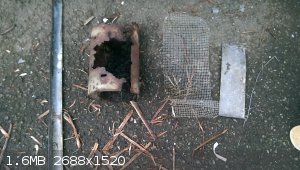 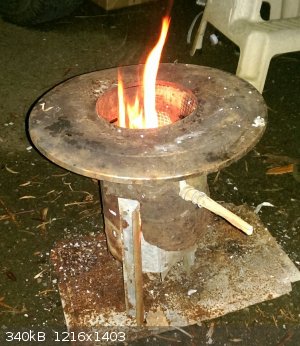 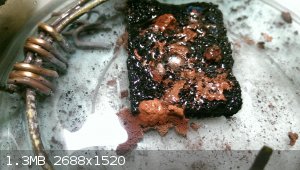 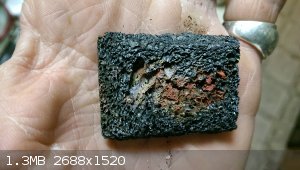
Been messing around with the first samples I made, soaked one in crude copper sulfamate and got some copper sponge to grow across/through the porous
carbon. Its baking now. Third time through. 1) no conductance, 2) meager conductance in several spots, 3) still cooling. Thinking electroplating
it slowly at very low amperage after improving the overall conductivity of the sample. Small metal dendrites may be fun.
Decided would try copper doping first as 1, soluble Ni for later and prety much only when needed, 2. Ammonia + Copper salts = soluble cellulose for
the next trial.
Piece #2, pre carbonized, is soaking in Ni sulfamate and has been wrapped in thinned out cotton ball material. Tied with a fillament of same twisted
to make thread. Thinking of adding a honey glaze or cellulose washes to tighten it up and add an even coating. After reading for a bit came across
this VVV 
________
Facile synthesis of graphene, graphene derivatives and abrasive nanoparticles and their various uses, including as tribologically-beneficial lubricant
additives
CA 2857947 A1
https://www.google.com/patents/CA2857947A1?cl=en
" Test 5... In another method of synthesis of nanoparticles,
powdered sugar, hand sanitizer, isopropanol ("99%), baking powder and mineral oil ("Walgreens Mineral Oil Intestinal Lubricant"
... were combined in a flask. The flask was heated with a direct flame to convert the sugar to graphitic carbon. The top of the flask was stoppered
and tubing directed the reaction gas stream containing the vapor-exfoliated graphene scales to bubble into a water bath.
A metal spatula... to collect the reaction product .. after being transported by the vapor stream. ... was then wiped against a carbon TEM grid ...
was observed using a ... the images. These structures are similar ... to as holey carbon or lacey carbon... shows a fairly large, uniform graphene
sheet morphology... shows a large graphene sheet morphology with a tendril ...shows folded multilayer graphene sheets... show thin strands of graphene
connecting larger sheet areas... showing a higher magnification of the multiple layers of such a strand.
________________________
Now I didn't add the photos, but good lord that is an easy one eh? Also used were things like honey, high fructose corn syrup, and whole host of
sweets, inver sugars, etc.
Other papers I came across were likewise interesting. For instance the carbonization of bacterial cellulose, including acetobacterium(sp?) mat. And
one that had freezedried bacterial cellulose backfilled with siloxane of some variety( forget the specifics, was 2am). Heated at some point and made
flexible conductors...
http://www.nature.com/am/journal/v4/n6/full/am201234a.html
graphite film from bacterial cellulose
http://scitation.aip.org/content/aip/journal/jap/68/4/10.106...
Carbon aerogels from bacterial cellulose > lithium ion batt electrode
http://pubs.rsc.org/en/content/articlehtml/2014/ra/c3ra47853...
-VS
We did eat those mushrooms, look forward to it each and every year. Been doing so since about 25 yrs ago
[Edited on 17-11-2016 by violet sin]
|
|
|
mayko
International Hazard
    
Posts: 1218
Registered: 17-1-2013
Location: Carrboro, NC
Member Is Offline
Mood: anomalous (Euclid class)
|
|
Someone brought some nasty BlunderBread hamburger buns to my 4th of July cookout and they've been sitting in the fridge since. Finally, a use for
them!
Here is related research from the same team, published last year, with an emphasis on supercapacitors:
Deng, J., Xiong, T., Xu, F., Li, M., Han, C., Gong, Y., … Wang, Y. (2015). Inspired by bread leavening: one-pot synthesis of hierarchically porous
carbon for supercapacitors. Green Chem., 17(7), 4053–4060. http://doi.org/10.1039/C5GC00523J
| Quote: |
Hierarchically porous carbons (HPCs) show great potential in energy storage due to their high surface area as well as short ion transport path derived
from the interconnected porous framework. However, most existing protocols highly rely on nanocasting and soft-templating, which usually make the use
of specific raw materials and thus their industrial application unfeasible. It still remains a big challenge to build HPCs from crude biomass, which
is abundant on the earth, through a simple one-pot approach. Inspired by leavening of bread, we design a strategy to fabricate HPCs with
three-dimensional (3D) hierarchical pores consisting of macro, meso, and micropores. The “leavening method” is conducted simply by mixing the
biomass with KHCO3 followed by elevated temperature treatment. Besides the well-defined hierarchical structure, the as-prepared HPCs also exhibit
notably large specific areas (up to 1893 m2 g−1). It is noteworthy that this “leavening” strategy is widely applicable to most of the biomass
derivatives and biomass, including glucose, cellulose, chitin, starch, rice straw, bamboo, etc. When evaluated as supercapacitor electrode materials
in two-electrode test systems, the as-prepared HPCs exhibit an excellent electrochemical performance: a specific capacitance of 253 F g−1, with
almost no capacitance loss after 10 000 cycles.
|
(yes, I am procrastinating at work by skimming through every issue of Green Chemistry; stop judging me.)
Regarding microwaves, I've never met a form of carbon which doesn't arc and spawn plasma balls when irradiated. The best for this effect is burn
newsprint or burn cork, but wood charcoal, pencil graphite, soot, even nanotubes will also work.
Attachment: Inspired by bread leavening- one-pot synthesis of hierarchically porous carbon for supercapacitors.pdf (2.2MB)
This file has been downloaded 481 times
al-khemie is not a terrorist organization
"Chemicals, chemicals... I need chemicals!" - George Hayduke
"Wubbalubba dub-dub!" - Rick Sanchez
|
|
|
aga
Forum Drunkard
    
Posts: 7030
Registered: 25-3-2014
Member Is Offline
|
|
Excellent stuff VC !
Burnt Toast is the Future.
|
|
|
elementcollector1
International Hazard
    
Posts: 2684
Registered: 28-12-2011
Location: The Known Universe
Member Is Offline
Mood: Molten
|
|
About to try this in a dormitory oven. So far, my procedure is:
-Wrap slices of bread in aluminum foil. I'm going to test the effect of nonuniform thickness (read: that awful end piece of the loaf) versus uniform
thickness on mechanical properties.
-Bake wrapped bread at 500 F (260 C) for 1 hour.
-Remove, and test.
Future testing will include attempting to make a carbon reactor chamber for a high-temperature furnace, as the stuff I'm currently using for
insulation isn't that great.
The brand I'm using is Schwebel's Giant Bread, which appears to be a knockoff of Wonder Bread.
Results in an hour!
Elements Collected:52/87
Latest Acquired: Cl
Next in Line: Nd
|
|
|
elementcollector1
International Hazard
    
Posts: 2684
Registered: 28-12-2011
Location: The Known Universe
Member Is Offline
Mood: Molten
|
|
Well, here they are!
Some photos of the bread, pre-baking:
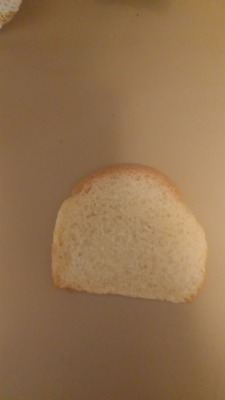
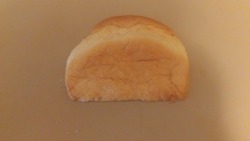
The slices were individually wrapped in foil packets, as shown:
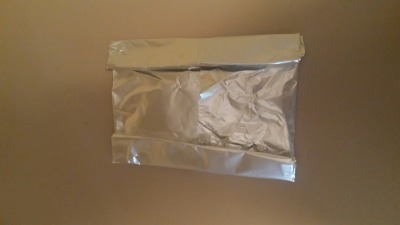
Once this was done, they were baked at 260 degrees C for exactly one hour. Then, they were taken out of the oven and left to cool. Once cool, they
looked like this:
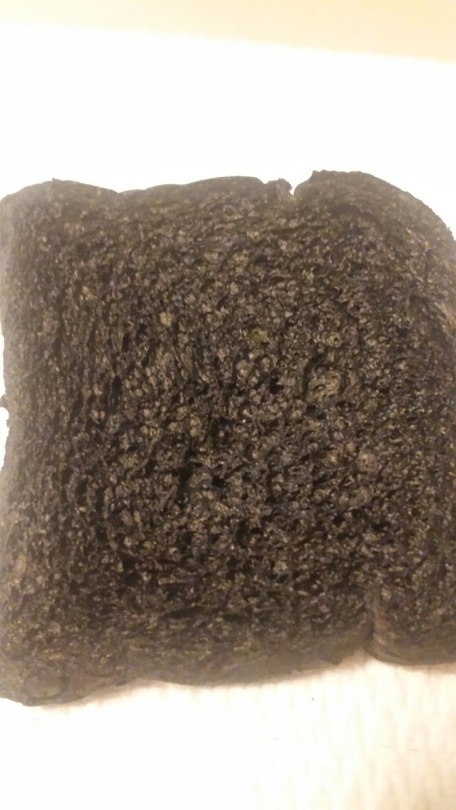
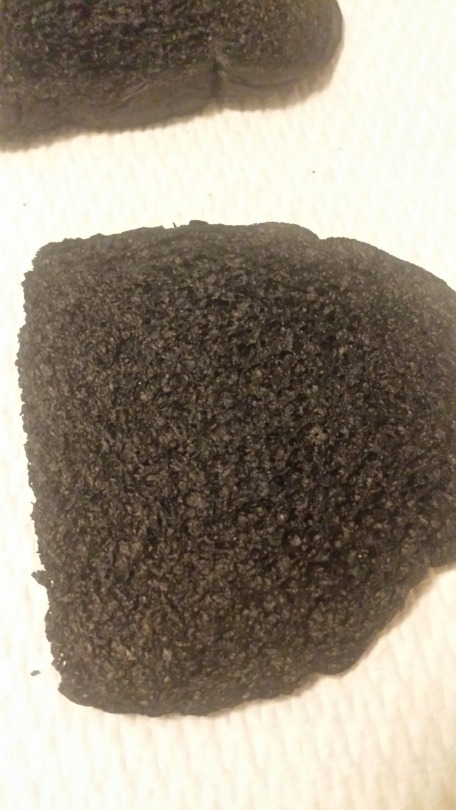
As you can see, the porous structure and general shape is retained. However, a little bit of the volume was lost (it's a bit hard to see in this
photo):
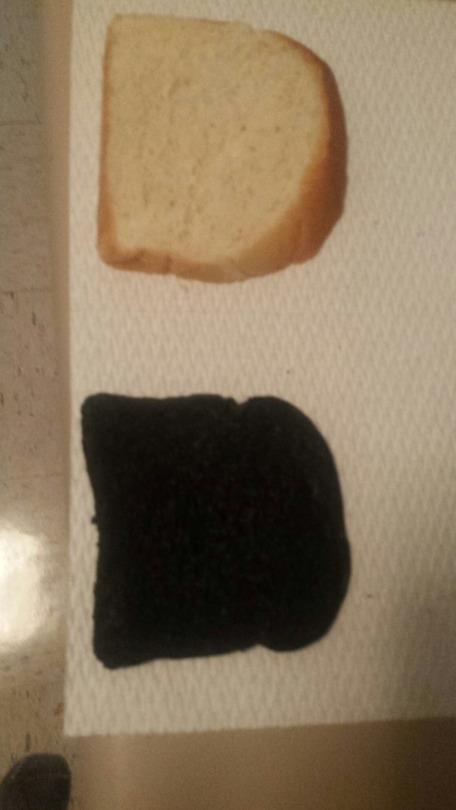
The resultant product behaves like a firebrick, in that while it is quite resistant to breaking, it abrades easily. Finally, the two samples were
snapped in half to test how they would fracture:
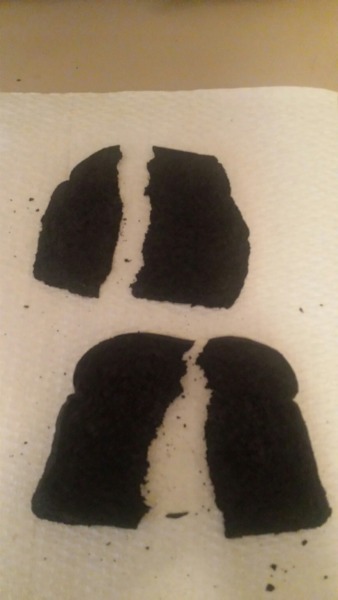
To my surprise, they snap cleanly down the middle! This indicates good structural rigidity of the carbon foam.
Electrical results will follow later, and temparature results may have to wait for now (no access to a blowtorch). Still, this was an extremely easy
experiment to carry out, and produces a rather useful material!
EDIT: Electrical results in! This stuff has a resistivity of, at the very least, 3.94 x 10^5 ohms per cm, putting it about on par with cement or
limestone in terms of resistivity.
[Edited on 11-19-2016 by elementcollector1]
Elements Collected:52/87
Latest Acquired: Cl
Next in Line: Nd
|
|
|
Jstuyfzand
Hazard to Others
  
Posts: 166
Registered: 16-1-2016
Location: Netherlands
Member Is Offline
Mood: Learning, Sorta.
|
|
It amazes me that 260C achieved this.
Great work!
|
|
|
aga
Forum Drunkard
    
Posts: 7030
Registered: 25-3-2014
Member Is Offline
|
|
Superb work there elementcollector1 !
It would be great if anything can be added before/during/after to make an excellent catalyst or something.
|
|
|
violet sin
International Hazard
    
Posts: 1475
Registered: 2-9-2012
Location: Daydreaming of uraninite...
Member Is Offline
Mood: Good
|
|
Thought 1) So what if we soaked the once charred bread in epsom salt sol. In a form fitting container, then dosed the lot with ammonia/lye to drop
Mg(OH)2 into the carbon scaffolding and re-baked it? Maybe something more structural could be produced for fire brick like material. Just
a thought. Also, sodium aluminate, TSP or calcium acetate could be candidates. Would be wonderful to use a conventional oven to make bits for a
hobby high temp oven.
2) still working on the cellulose coating project. Dollar store ammonia is WEAK sauce. You can stick your nose right in the jug and barely smell
anything = waste of $. So I went to a True Value hardware stor and got "magestic extra strength ammonia cleaner" for 3$... Got home and read
MSDS,... A whopping 4% con. in that mix. It's going back today, and I will be buying a jug of janitorial ammonia @ 10% strength. The idea here is to
dissolve cotton balls into sol. add the preburnt bread and acidify to drop cellulose in the pores/on the surface. Could potentially add a LOT of
surface area if it works.
I'm still away from home so it sux to buy stuff again that is laying around the lab, but darnit I want to know  the family isn't in town and I have the day off, a bag of briquetts and that new stove ... Gonna get me some
answers. Along with some more bread kinds to try. The french bread from safeway was good, but sourdough had huge irregular pockets that made for a
dissapointing outcome when sawed into slabs. Check back later today, hopefully with more info than ponderings the family isn't in town and I have the day off, a bag of briquetts and that new stove ... Gonna get me some
answers. Along with some more bread kinds to try. The french bread from safeway was good, but sourdough had huge irregular pockets that made for a
dissapointing outcome when sawed into slabs. Check back later today, hopefully with more info than ponderings
|
|
|
Morgan
International Hazard
    
Posts: 1660
Registered: 28-12-2010
Member Is Offline
Mood: No Mood
|
|
Maybe some water glass would be something to try.
"Water glass was defined in Von Wagner's Manual of Chemical Technology (1892 translation) as any of the soluble alkaline silicates, first observed by
Jean Baptist van Helmont circa 1640 as a fluid substance made by melting sand with excess alkali."
Refractory use
Water glass is a useful binder of solids, such as vermiculite and perlite. When blended with the aforementioned lightweight aggregates, water glass
can be used to make hard, high-temperature insulation boards used for refractories, passive fire protection and high temperature insulations, such as
moulded pipe insulation applications. When mixed with finely divided mineral powders, such as vermiculite dust (which is common scrap from the
exfoliation process), one can produce high temperature adhesives. The intumescence disappears in the presence of finely divided mineral dust, whereby
the waterglass becomes a mere matrix. Waterglass is inexpensive and abundantly available, which makes its use popular in many refractory applications.
https://en.wikipedia.org/wiki/Sodium_silicate
|
|
|
aga
Forum Drunkard
    
Posts: 7030
Registered: 25-3-2014
Member Is Offline
|
|
As seen Done, this is the perfect Do-For-Yourself-and-See experiment.
No need to wait on a superior Chemist who has access to advanced materials, such as
Bread, Tinfoil and Fire.
Words play no part in this, as Anyone can try it for themself.
Online words are so easy, compared to actually doing something.
Words after Doing Something are far, far more interesting, as this thread shows.
Nobody on this planet has any valid excuse when it comes to over-toasting bread.
|
|
|
| Pages:
1
..
3
4
5
6
7
..
10 |
|